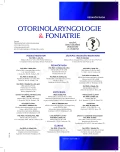Silent Sinus Syndrome
Authors:
J. Lazák 1; J. Lisý 2; D. Kalfeřt 1; J. Plzák 1
Authors‘ workplace:
Klinika otorinolaryngologie a chirurgie hlavy a krku, 1. lékařská fakulta, Univerzita Karlova, Fakultní nemocnice Motol, Praha
1; Klinika zobrazovacích metod, 2. lékařská fakulta, Univerzita Karlova, Fakultní nemocnice Motol, Praha
2
Published in:
Otorinolaryngol Foniatr, 67, 2018, No. 3, pp. 58-61.
Category:
Case Reports
Overview
Silent sinus syndrome (SSS) is a rare disease of the maxillary sinus. It is characterized by idiopathic and spontaneous enophthalmos due to the collapse of the orbital floor and maxillary sinus atelectasis. In our case report we describe a 17 – teen years old women with and accidental finding of SSS. The absence of typical clinical symptoms, low patient age and non-standard diagnostic procedures make this case interesting. The pathophysiology, symptomatology, diagnostic management and treatment are discussed.
Keywords:
silent sinus syndrome, enophthalmos, hypoglobus
Sources
1. Andrašovská, M., Mudrák, J., Kovaľ, J.: Mukokela a pyokela prinosových dutín. Otorinolaryng. a Foniat. /Prague/, 51, 2002, 2, s. 111-115.
2. Brandt, M. G., Wright, E. D.: The silent sinus syndrome is a form of chronic maxillary atelectasis: a systematic review of all reported cases. Am. J. Rhinol., 22, 2008, 1, s. 68-73.
3. Burroughs, J. R., Hernandez Cospin, J. R., Soparkar, C. N. et al.: Misdiagnosis of silent sinus syndrome. Ophthal. Plast. Reconstr. Surg., 19, 2003, 6, s. 449-454.
4. Dailey, R. A., Cohen, J. I.: Surgical repair of the silent sinus syndrome. Ophthal. Plast. Reconstr. Surg., 11, 1995, 4, s. 261-268.
5. Farneti, P., Sciarretta, V., Macri, G. et al.: Silent sinus syndrome and maxillary sinus atelectasis in children. Int. J. Pediatr. Otorhinolaryngol., 98, 2017, s. 150-157.
6. Gaudino, S., Di Lella, G. M., Piludu, F. et al.: CT and MRI diagnosis of silent sinus syndrome. Radiol. Med., 118, 2013, 2, s. 265-275.
7. Kass, E. S., Salman, S., Rubin, P. A. et al.: Chronic maxillary atelectasis. Ann. Otol. Rhinol. Laryngol., 106, 1997, 2, s. 109-116.
8. Kilty, S. J.: Maxillary sinus atelectasis (silent sinus syndrome): treatment with balloon sinuplasty. J. Laryngol. Otol., 128, 2014, 2, s. 189-191.
9. Martinez-Capoccioni, G., Varela-Martinez, E., Martin-Martin, C.: Silent sinus syndrome an acquired condition and the essential role of otorhinolaryngologist consultation: a retrospective study. Eur. Arch. Otorhinolaryngol., 273, 2016, 10, s. 3183-3188.
10. Mavrikakis, I., Detorakis, E. T., Yiotakis, I. et al.: Nonsurgical management of silent sinus syndrome with hyaluronic acid gel. Ophthal. Plast. Reconstr. Surg., 28, 2012, 1, s. e6-7.
11. Montgomery, W. W.: Mucocele of the maxillary sinus causing enophthalmos. Eye Ear Nose Throat Mon., 43, 1964, s. 41-44.
12. Pula, J. H., Mehta, M.: Silent sinus syndrome. Curr. Opin. Ophthalmol., 25, 2014, 6, s. 480-484.
13. Rose, G. E., Sandy, C., Hallberg, L. et al.: Clinical and radiologic characteristics of the imploding antrum, or „silent sinus,“ syndrome. Ophthalmology, 110, 2003, 4, s. 811-818.
14. Soparkar, C. N., Patrinely, J. R., Cuaycong, M. J. et al.: The silent sinus syndrome. A cause of spontaneous enophthalmos. Ophthalmology, 101, 1994, 4, s. 772-778.
15. Soparkar, C. N., Patrinely, J. R., Davidson, J. K.: Silent sinus syndrome-new perspectives? Ophthalmology, 111, 2004, 2, s. 414-415; author reply s. 415-416.
16. Thomas, R. D., Graham, S. M., Carter, K. D. et al.: Management of the orbital floor in silent sinus syndrome. Am. J. Rhinol., 17, 2003, 2, s. 97-100.
17. Trope, M., Schwartz, J. S., Tajudeen, B. A. et al.: Bilateral silent sinus syndrome: A rare case and review of literature. Allergy Rhinol. (Providence), 8, 2017, 2, s. 100-102.
18. Warwar, R. E., Rogers, D. L.: Exophthalmos and orbital floor thickening related to maxillary sinusitis. Ophthal. Plast. Reconstr. Surg., 19, 2003, 2, s. 158-159.
Labels
Audiology Paediatric ENT ENT (Otorhinolaryngology)Article was published in
Otorhinolaryngology and Phoniatrics

2018 Issue 3
Most read in this issue
- The Survey of Implants for Bone-Conducted Hearing and Active Middle Ear Implants
- Spontaneous Sublingual Haematoma as a Manifestation of an Acquired Haemophilia
- Silent Sinus Syndrome
- Role of Audiological Methods in Diagnostics of Lesions in the Pontocerebellar Angle
